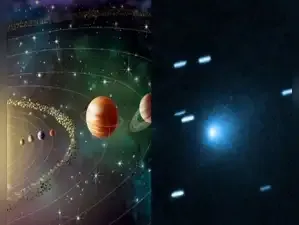The interstellar comet 3I/ATLAS has managed to capture the attention of the global science community and will reach its closest point to the Sun on October 30. The discovery of 3I/ATLAS, the third comet from another solar system ever seen, has greatly excited scientists in the field.
This is a "hugely exciting discovery," Darryl Seligman, a professor in the physics and astronomy department at Michigan State University, told Newsweek. Interstellar comets are rare finds, making the discovery of 3I/ATLAS particularly interesting to planetary scientists.
ALSO READ: Interstellar comet 3I/ATLAS surprises astronomers again: Mysterious cosmic visitor extends strange tendril toward the Sun
"This is only the third such interstellar comet we've ever been able to study, and planetary scientists are super excited to learn about what comets in other solar systems are like," Jason Wright, a professor of astronomy and astrophysics and director of the Penn State Extraterrestrial Intelligence Center at Pennsylvania State University, told Newsweek.
"Comets form early in a star's life, along with the planets that orbit them," Wright said. "Most stay around their star and occasionally get close and grow a tail, but a few can be thrown out of their system by gravity of the planets and end up floating in interstellar space."
What is Comet 3I/ATLAS?
The comet was first discovered on July 1 by the NASA-funded ATLAS (Asteroid Terrestrial-impact Last Alert System) survey telescope in Rio Hurtado, Chile, and given its official name, 3I/ATLAS.
At the time, it was located about 670 million kilometers from Earth. NASA determined it "poses no threat to Earth," and that it will remain at a distance of at least 240 million kilometers from the planet.
Before 3I/ATLAS, there were two other interstellar objects discovered. These were 1I/`Oumuamua and 2I/Borisov, discovered in 2017 and 2019, respectively.
ALSO READ: Comet 3I/ATLAS shows strange light patterns: NASA's secret move revealed after interstellar visitor's odd behaviour
"We know these objects are from elsewhere in the galaxy because they have hyperbolic orbits, unbound from the solar system—they arrive, then they leave and they never return," Seligman said.
However, one scientist, Abraham "Avi" Loeb, a professor of science and director of the Institute for Theory and Computation
at Harvard University thinks there could be a 30 to 40 percent chance it is "alien technology."
Loeb's reasoning for this is that he says the comet has displayed eight "abnormalities."
These "abnormalities" include: 3I/ATLAS is significantly larger than both previous interstellar comets found, while moving faster; the fact that it will be "unobservable from Earth" at the point where it is closest to the Sun; "the gas plume around 3I/ATLAS contains much more nickel than iron;" as well as a number of others.
ALSO READ: Alaska Airlines flights grounded for second time in a year: What caused the nationwide disruption and when will the services resume?
What will happen on October 29?
On October 29, the comet will reach its closest point to the sun. This point, known as perihelion, usually results in conditions that provide the ideal circumstances for scientists to gain a better understanding and glimpse of the comet's composition. "Every comet by definition has a close approach to the sun," Seligman said. That point is when the comet has the "most direct sunlight, so it is at its warmest," he added.
This causes different ices to start "activating at different temperatures," meaning "you get the most ices possible," he said.
"Observations of a comet near perihelion are kind of like getting the most bang for your buck—you have the best shot of getting the most holistic view of the comet’s composition because the most possible ices should be active," Seligman added. According to NASA, 3I/ATLAS will reappear on the other side of the sun by early December.
This is a "hugely exciting discovery," Darryl Seligman, a professor in the physics and astronomy department at Michigan State University, told Newsweek. Interstellar comets are rare finds, making the discovery of 3I/ATLAS particularly interesting to planetary scientists.
Is comet spitting out gas and dust toward the Sun?
Newly released images of the interstellar comet 3I/ATLAS appear to show the alien object spitting out an enormous jet of gas and dust toward the sun — in line with the expected behaviour of the comets, as per Live Science. Created by stacking 159 exposures of 50 seconds each, the composite image reveals the icy core (or nucleus) of comet 3I/ATLAS as a dark central dot encircled by a bright white halo. A sharp, fan-shaped gap in this halo marks the spot where scientists say a powerful jet of material — shown in purple — is erupting from the comet and streaming toward the Sun.ALSO READ: Interstellar comet 3I/ATLAS surprises astronomers again: Mysterious cosmic visitor extends strange tendril toward the Sun
"This is only the third such interstellar comet we've ever been able to study, and planetary scientists are super excited to learn about what comets in other solar systems are like," Jason Wright, a professor of astronomy and astrophysics and director of the Penn State Extraterrestrial Intelligence Center at Pennsylvania State University, told Newsweek.
"Comets form early in a star's life, along with the planets that orbit them," Wright said. "Most stay around their star and occasionally get close and grow a tail, but a few can be thrown out of their system by gravity of the planets and end up floating in interstellar space."
What is Comet 3I/ATLAS?
The comet was first discovered on July 1 by the NASA-funded ATLAS (Asteroid Terrestrial-impact Last Alert System) survey telescope in Rio Hurtado, Chile, and given its official name, 3I/ATLAS.At the time, it was located about 670 million kilometers from Earth. NASA determined it "poses no threat to Earth," and that it will remain at a distance of at least 240 million kilometers from the planet.
Before 3I/ATLAS, there were two other interstellar objects discovered. These were 1I/`Oumuamua and 2I/Borisov, discovered in 2017 and 2019, respectively.
ALSO READ: Comet 3I/ATLAS shows strange light patterns: NASA's secret move revealed after interstellar visitor's odd behaviour
"We know these objects are from elsewhere in the galaxy because they have hyperbolic orbits, unbound from the solar system—they arrive, then they leave and they never return," Seligman said.
However, one scientist, Abraham "Avi" Loeb, a professor of science and director of the Institute for Theory and Computation
at Harvard University thinks there could be a 30 to 40 percent chance it is "alien technology."
Loeb's reasoning for this is that he says the comet has displayed eight "abnormalities."
These "abnormalities" include: 3I/ATLAS is significantly larger than both previous interstellar comets found, while moving faster; the fact that it will be "unobservable from Earth" at the point where it is closest to the Sun; "the gas plume around 3I/ATLAS contains much more nickel than iron;" as well as a number of others.
ALSO READ: Alaska Airlines flights grounded for second time in a year: What caused the nationwide disruption and when will the services resume?
What will happen on October 29?
On October 29, the comet will reach its closest point to the sun. This point, known as perihelion, usually results in conditions that provide the ideal circumstances for scientists to gain a better understanding and glimpse of the comet's composition. "Every comet by definition has a close approach to the sun," Seligman said. That point is when the comet has the "most direct sunlight, so it is at its warmest," he added.This causes different ices to start "activating at different temperatures," meaning "you get the most ices possible," he said.
"Observations of a comet near perihelion are kind of like getting the most bang for your buck—you have the best shot of getting the most holistic view of the comet’s composition because the most possible ices should be active," Seligman added. According to NASA, 3I/ATLAS will reappear on the other side of the sun by early December.








